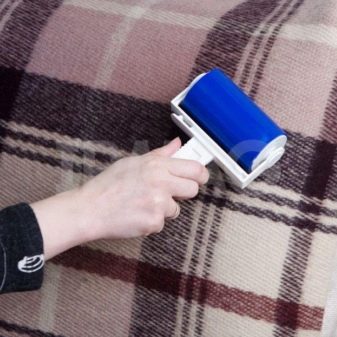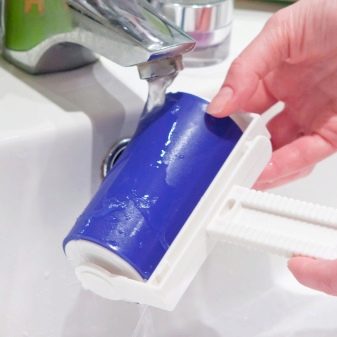All About Cleaning Rollers
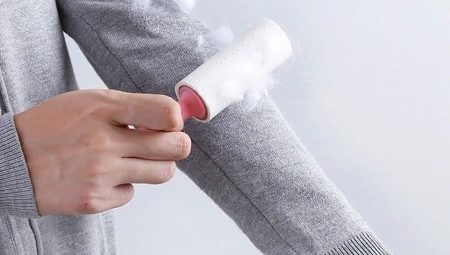
Even a carefully thought-out look will not be complete if the clothes are unkempt. This is especially true for dark fabrics, the appearance of which must be impeccable. A special roller for quick cleaning of any surfaces can help with their care.


What it is?
Rollers (rollers, rollers) are disposable and reusable, with paper sheets, polyurethane and silicone surfaces. Despite the differences in materials, they all work according to the same principle: they collect dust, wool and other dirt from the fabric on the adhesive surface.
A contaminated device must be cleaned after use and prepared for the next handling. To do this, remove the sticky layer from it or simply rinse it under the tap. The cleaning method depends on the type of roller.
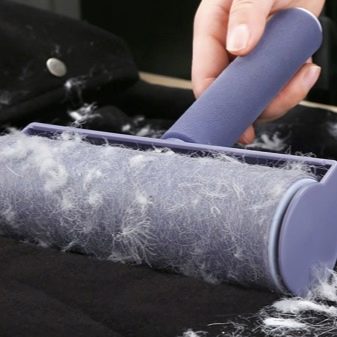

Rollers for cleaning clothes are very compact, there are even pocket options. This is very convenient because you can take them with you and, if necessary, use them outside the home. For example, taking your hair out of your jacket during the working day or tidying up your suit before a business meeting.
The roller diameter can be from 3 to 5 centimeters. The manufacturer provides 10 centimeters for the length of the working unit. For the convenience of handling the roller, an ergonomic plastic handle has been thought out.
These products are intended not only for cleaning clothes from stuck animal hair and dust particles. They are in demand by tidy and thrifty people who are used to looking perfect in any situation.
A roller with adhesive tape is indispensable in the interior of the car and allows you to collect small debris in the most inaccessible places. It is very practical, convenient and economical.Compared to using a vacuum cleaner, the roller can help save energy.

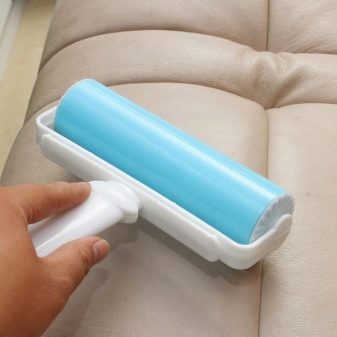
The advantages of the device are as follows:
- in comparison with a conventional brush for clothes, the sticky roller perfectly collects wool, hair and dust, preventing dirt from penetrating into deeper layers of matter;
- sticky impregnation does not harm the fabric, when it comes into contact with the surface to be cleaned, it does not leave any traces on it, does not electrify the fabric;
- gentle cleaning of the fabric guarantees the absence of snags and puffs on it;
- the roller is easy to wash or clean;
- the adhesive tape is impregnated with a harmless compound;
- convenient design makes cleaning easier;
- replaceable units are sold in most retail outlets and change quickly;
- thanks to the high-quality perforation, the adhesive tape can be easily removed after use.

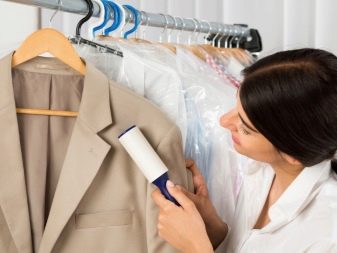
Disadvantages noted by users:
- the washable surface of the reusable roller has to be washed after each use;
- some models collect dust and hair particles not one hundred percent, even in several passes;
- dirt sticks to adhesive sheets, but not on all models they come off conveniently;
- silicone quickly loses the stickiness of the working base;
- sometimes the handle on the device is unreliable and breaks quickly.
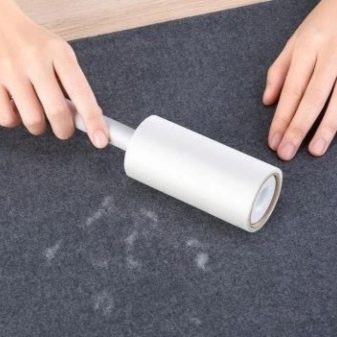

Species overview
There are three types of rollers with an adhesive surface:
- paper, with a reel with tear-off sheets;
- washable, with a sticky working block;
- reusable, with silicone adhesive surface.


Paper
The cleaning roller is threaded onto a base made of plastic with a comfortable handle. The standard is a cardboard tube with 24-60 sticky sheets. It is disposable and reusable.
The disposable roller will have to be thrown away after all the sticky layers are used up.... In a reusable roller, a new work unit can be put on the base. It is purchased separately or supplied as a set with the main roller. Often a set of blocks is included in the package.
Sheets with a uniform adhesive layer and side notches are popular with consumers for their ease of use. They are designed for prompt cleaning of surfaces from dust, dandruff, hairs, and are suitable for processing furniture upholstery and car interiors.
With a universal device, you can easily clean not only fabric, but also dusty walls, ceilings, and clean fabric from pellets.
The roller collects impurities in one roll on the fabric, leaving no traces of glue. The manufacturer has thought of a system for easy replacement of a used block with a working one. The replaceable block is securely fixed in place of the used roller.
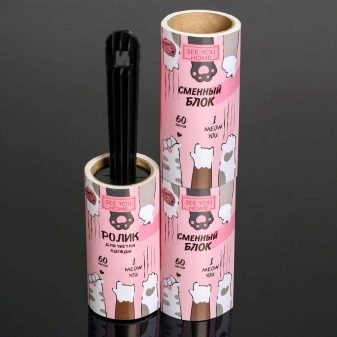
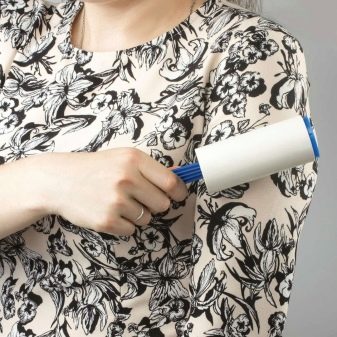
Washable
Reusable roller with adhesive-treated polyurethane working surface. To prevent dust from sticking to the adhesive surface during storage, a plastic case is provided for the roller.
In a washable roller the unit cannot be replaced. Manufacturers do not provide such spare parts. The roller is designed for the same needs as the paper counterpart. That is, it will easily collect dust, wool, lint, etc. from the surface. The adhesive layer will not harm even delicate matter.
To restore the stickiness of the sticky layer, it is enough to rinse the roller with warm water. This implies the use of the roller up to 100 times, which is equivalent to approximately three months of operation. It is much more economical compared to a paper roll.
Some reusable washable options come with a rubber brush. It allows you to more effectively remove dirt.


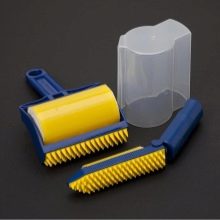
Silicone
The reusable rollerball consists of a base with a comfortable handle and a block covered with a sticky material that collects dirt. Many compact models are foldable. Thanks to this, it is convenient to carry them with you in your purse or pocket, take them on trips, to study or to work.
Unlike paper blocks, the silicone surface of the roller is easy to clean. This approach ensures a long service life and significantly saves the budget.
The unit is held securely on the ergonomic handle, which guarantees comfortable use.
The supplied plastic case protects the soft and sticky surface from dirt and deformation.
Can be used on all types of fabrics including leather, suede, nubuck, velor, etc.
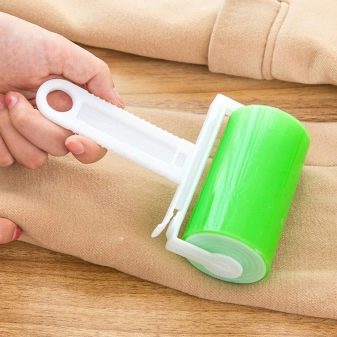
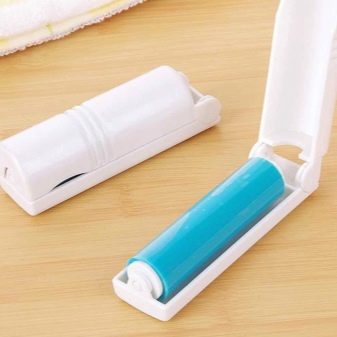
Judging by the numerous reviews, the priority still remains the paper version of the roller. It does not need rinsing, it perfectly collects dust, wool and hair... To start a new cleaning, it is enough to remove the used sheet and continue manipulating the clean and sticky area.
Nuances of choice
When choosing a roller for cleaning fabrics, you should pay attention to the following nuances:
- it is better to give preference to a roller with a tape with a spiral perforation. Its advantage over a block with straight perforation is that it simplifies tearing off the contaminated area;
- it is best to purchase a roller with a plastic handle with a hole, it is very convenient in operation, the roller can be stored in a suspended state;
- it is more practical to choose a roller with a closing lid, its presence will protect the sticky layer from drying out and dust adhesion.
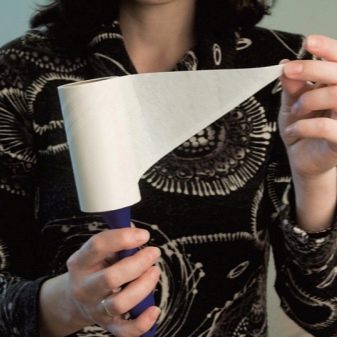
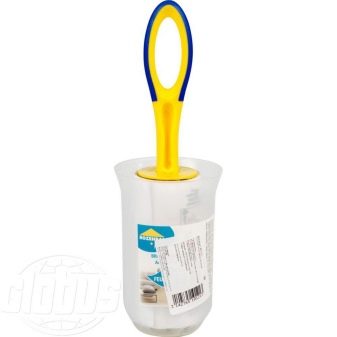
How to use it correctly?
It is enough to make one light movement on the fabric, and the surface will regain its former cleanliness. A rollerball for cleaning clothes is very helpful due to its versatility. Such a thing can be used both for its intended purpose and in different directions in everyday life. For example, using a sticky surface you can clean:
- fabric upholstery of carpets, upholstered furniture;
- car interior, including the dashboard;
- lamp shade;
- dark curtains and dusty blinds of any kind;
- cobweb angles;
- children's toys that accumulate dust harmful to children;
- the inside of a bag or deep backpack, where a lot of small debris accumulates over time. The sticky roller will collect all the crumbs, scraps of thread, pieces of paper, etc.;
- drawers of dressers or kitchen tables;
- the surface of the table and floor from broken glass, sparkles, serpentine and other small particles from various materials, regardless of the fraction and texture.
The sticky roller can be a good "silent" vacuum cleaner for collecting hair directly on the shedding pet.
The roller is convenient to use to remove the pellets and is practical to carry with you to the hairdresser. After a haircut, it is easy for them to clean their neck, collar and walk through the clothes, collecting all the cut hairs.
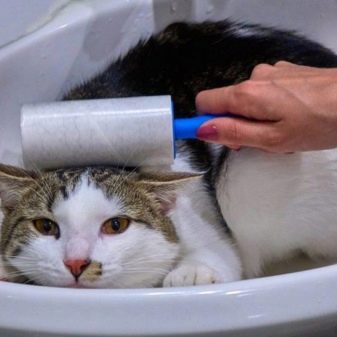
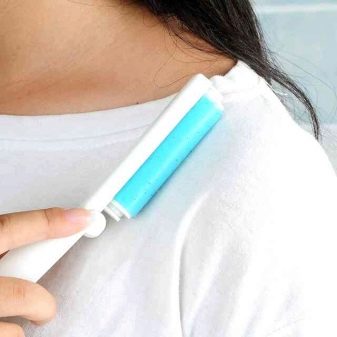
The paper block is used as follows:
- before starting work, you must remove the protective sheet from the paper roller;
- then, with the sticky base, make rolling movements over the fabric;
- when the surface is so dirty that it ceases to be sticky, you need to remove the layer of debris, for this the edge of the used sheet is picked up, removed and torn off along the perforation line;
- to use the roller again when the sticky layers are gone, you just need to change the block to a removable analog.

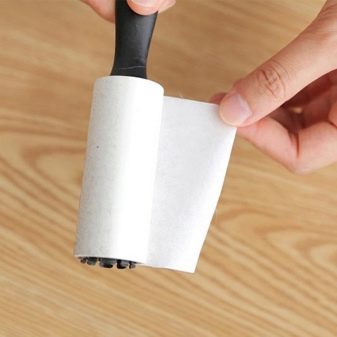
Reusable washable rollers are used in much the same way.
During the unpacking process, before using for the first time, the packing tape is removed. Further, the places of contamination are processed with a sticky roller.
It is easy to return the stickiness to the roller; you just need to rinse the contaminated block with warm water. It is very convenient to do this right under the tap, the water jet itself rotates the roller, and all the dirt is washed off instantly. Literally 15 seconds and the video is ready to perform its task again. Before sending the cleaned block to storage, the device must be shaken and placed in a case. This will prepare it for use next time.
This is a very practical solution for those who are used to keeping things clean and saving on budget.
